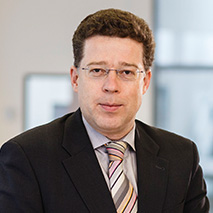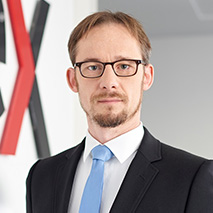Blockchain technology – A game changer for the energy industry?
Answers by Paul-Georg Garmer, Senior Manager Public Affairs at the TenneT TSO, and Dr Maximilian Rinck, export for electricity market design at the European Energy Exchange (EEX).
More information:
If you want to learn more about blockchain technology and how it works, go to our direct account section.
FOR: Paul-Georg Garmer
 © TenneT
© TenneT
GThe energy transition is profoundly changing the German energy sector. Electricity is no longer being generated in just a few large-scale power plants, but in thousands of distributed renewables installations. Together with battery storage facilities and demand side management, these installations will soon also be providing ancillary services. We need to explore new avenues that will allow us to flexibly steer our power generation and ensure a sufficient supply in all types of weather. Every electricity customer who is able to adjust their demand in a flexible way must be able to sell this flexibility, regardless of which voltage level is affected by this.
This is where blockchaining comes in. It can be used to smartly and securely interconnect individual distributed installations and integrate these into a superregional flexibility market. This in turn can reduce the need for expensive action to be taken in the interest of grid stability, such as limiting the output of wind turbines. Innovative blockchaining projects can be used to complement the efforts for grid expansion. If we make greater use of data on electricity generation and of new flexibilities that become available, this can help us use intermittent green electricity in a more efficient way and integrate it better. This is why TenneT has launched two pilot projects to assess the potential of blockchaining. eServices have been used to create additional flexibility within home storage installations that are part of the same network. This helps manage bottlenecks within the grid. Furthermore, TenneT has been working with vandebron, a Dutch company, to interconnect charging points for cars, which provide secondary balancing power. Both pilot projects use storage facilities that use smart load management to adjust to the individual situation of the grid and are capable of feeding in or taking off any excess electricity within instants.
Soon, there will be millions of small-scale distributed electricity generators, prosumers and consumers. Blockchaining can do a lot to simplify interaction between the various stakeholders whilst also reducing customers' electricity bills. The method is also capable of being managed in a way that is compliant with the highest standards of data security and confidentiality.
Paul-Georg Garmer is Senior Manager Public Affairs with the Dutch/German TSO TenneT.
AGAINST: Dr Maximilian Rinck
 © EEX
© EEX
When we talk about Blockchain being a game changer, what we actually mean is that it has the potential to completely decentralise our energy trade, thereby eliminating intermediaries such as power exchanges and clearing houses from the value chain.
That said, the role of power exchanges and clearing houses is by no means limited to the premise of logistically bringing together supply and demand or of managing financial transactions.
Clearing houses have the vital function of assessing all potential traders to ensure that they are always able to meet their obligations in financial and physical terms and that they comply with legal requirements designed to prevent money laundering or for financing terrorism. Having transactions settled by a "central counterparty", reduces counterparty risks of long-term transactions for all market participants – including in a stressed market environment – and therefore provides a significant benefit compared to a system based solely on direct bilateral trade.
The most important tasks of the exchange and its market supervision are operating the marketplace itself, monitoring and securing trade to prevent manipulation and breaches of regulation as well as documenting market events by means of recording daily fixings. These official prices are also used as a reference for contracts concluded off-exchange or for calculating the market premium pursuant to the German Renewable Energy Sources Act. On a market lacking liquidity or on a new market, the only way to establish daily fixings would be by means of a survey of traders. The exchange as a central instance provides neutrality in the assessment of reliable price sources and guarantees their quality.
Blockchain is an information technology that has its legitimate application in post-trading or for organising small, decentralised energy markets at a regional level. Exchanges such as those operated by EEX Group have a key role to play on wholesale power markets, where they fulfil important tasks that cannot easily be decentralised or eliminated – not even by Blockchain.
Dr Maximilian Rinck is an expert for power market design at the European Energy Exchange (EEX).

